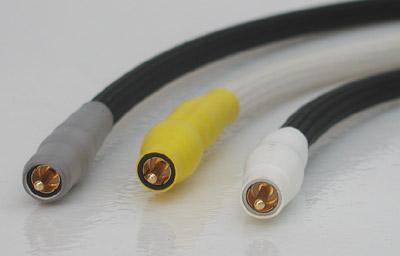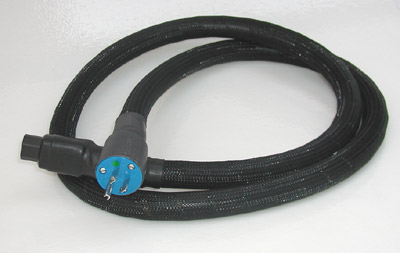You are reading the older HTML site
Positive Feedback
ISSUE
3
dynamic design
A threesome of digital cables and an introduction to an AC cable for digital gear
as reviewed by Dave Clark and Clay Swartz

DAVE CLARK'S SYSTEM: LOUDSPEAKERS ELECTRONICS SOURCES CABLES ACCESSORIES
|
Much of what audiophiles do defies common sense. Look at what we put ourselves through—financially and, more importantly, mentally—to build what we perceive to be a musically satisfying chain of boxes and wires. We spend hundreds, sometimes thousands, on cables and doodads that make subtle, yet oh-so-important differences in what we hear, spending hours painstakingly playing excerpts of "test cuts" in hopes getting things just that much better. Can wires, or cones, or whatever, make a difference? Yes, but whether the differences matter to you is another issue.
Digital cables are one of those things that particularly defy common sense (unless you are an audiophile), so of course, along comes a box of digital cables from another startup company, and I am faced with the root canal of all reviews. Do I really want to swap a variety of digital cables and listen over and over again to see which one rocks my world? No, but nobody else in our reviewing circle is dumb enough to still have separate digital components, or they are smart enough not to admit it, so I stepped up to the plate. (Perhaps this is the point in my life where I threw in the towel and sold the EVS and Audient boxes and bought the Cary 306/200. See the review at https://positive-feedback.com/Issue2/cary306.htm. Way simpler and way better with just one box!)
To make this simple, I removed the Audient Technologies Audit and Tactic devices from the chain and just went straight from my transport to the DAC. This way I could really hear what the cables did to the signal without the analog buffers mitigating cable anomalies. Compared to my JPS digital cable, the wires from Dynamic Design showed just how different digital cables can sound. I say they have a sound, but it is still hard for me to fathom, let alone describe, how digital cables sound. These cables are pricey and stiff. In audio, more money usually means bigger and stiffer, though in this case the bigger and stiffer means additional shielding and whatnot. Oh and yes more money!
Since not much was included in the box (other than the cables and a rather confusing price sheet) I am at a lost to say what really is going on here. These are very well made cables and should last a life-time as they are not the least bit fragile or tweeky in appearance. What I can say is that I tried the Whiteline ($600), Platinum ($900), and THB ($1600), and found a strong family resemblance amongst them. I spent a few weeks using the same material and going from one tot the other allowing a short time for any "settling." Like I said not a fun thing to do.
In looking at my notes I wrote that the Whiteline (the white cable in the picture above) was clear and articulate with great clarity and definition. It offered a lively sound that made the JPS appear somewhat darker and warmer with less, well, less "liveliness." I will admit that to some degree this added detail or presence can be an issue of cable jitter that comes across as detail. I did not find the cable to be the least bit tilted-up or bright, though I would not be out of line to assume that what I was hearing could be this artifact. Which is just what the Audit and Tactic are designed to mitigate. Even so, this was a very good cable. Differences were more an issue of being different than this being better than that.
The Platinum (the grey cable in the picture above) was very nice, being more lush and richer than the Whiteline. It was also smoother and less "lively", though just as articulate and clear. Perhaps a bit less forward, with a wider soundstage as well. In all respects this cable came very close to what I am used to with the JPS/Audit and Tactic in tow—which speaks very well for this $900 ticket—except the Audit and Tactic were, as I mentioned above, not in tow. Okay, that means this is a very good cable! But it is $900.
The top of the line THB (the yellow cable in the picture above) was also very clear—though more so than the other two less expensive cables—allowing one to hear far into the soundfield and recording. Talk about transparent and spacious. This is what one hears when the noise or jitter is removed from the signal—dead quiet. The THB was also the most extended and neutral—top to bottom—of the three. Unfortunately, this all comes with a perceived loss of musicality in that, "Do I really want to hear everything in the recording, but even more so, in the digital chain?" It is not that is was not musical, it is just that too much was revealed. I mean, the THB was just too good for my system. Mated with far better seperates than I own and this is pushing the envelope. But it is not an easy push at $1600.
Using the Audit and Tactic, differences between the cables were very subtle, which tells me that these two devices are necessary if one is to get the most out of any digital cable. It is too bad the company is defunct, as they are godsends.With the Audient devices out of the chain, the differences between these cables and mine were readily obvious. With them in the chain, the JPS was up there with the more expensive competition.
I would rate the Platinum as a best buy. This was by far my favorite cable of the three, as it was the best in all the areas that I find musically satisfying—it was warm, clear, grain free, but not too revealing or transparent—for my system and tastes. I have heard only one other digital cable that offers the best of both worlds. The Marigo Apparition (see my review elsewhere in this issue) is neck and neck with the Platinum. I would recommend either to anyone who wants to get the best there is, but can’t quite justify breaking the kilobuck barrier. Dave Clark
Dynamic Design Digital Power Cable

This, for me at least, is the Cadillac of power cables. It is about an inch in diameter, and it is very stiff. It is also fairly heavy, and may cause lightweight components to tip up in front. You’ll need an eight or nine-inch clearance at both ends to plug it in, and will probably need six more inches of cable to reach between components than with a more flexible cord. It is optimized for use in digital components; Dynamic Design also makes analog power cables.
My system is described in the "Meet the Staff" section on the Positive Feedback site. I have long felt that power cords were cost-effective improvements, but that spending more gave diminishing returns, until I tried the Dynamic Design cable. My modified Citation 7 preamp was the easiest component to change cords on, so I tried it there first. The improvement was immediately evident. Sound came out of a blacker soundstage. It was also more dynamic, yet more refined. There was a better sense of control and better detail. I was surprised by the amount of improvement. After returning my usual $175 API power cord to the Citation, I tried the DD cord on my Sony S-9000 ES, and noted the same kinds of improvements as I did with the preamp. A layer of confusion seemed to be lifted from the music. I wondered how much difference it would make to have them throughout the system.
Now for the real quandary. This cable is $1200 for six feet and $640 for each additional foot. The Platinum Reference analog cable is the same price for six feet and $375 for each additional foot. There is also a THB analog cord that is $2000 for six feet and $640 for each additional foot. The entry-level cable is $550 for six feet. The High Performance level is $750 for six feet. I would love to have some of this cable in my system, but cannot afford it. For those who can afford the best, this cable should be considered. I already miss having it in my system. Clay Swartz
More to come on this AC cable!
Sound Marketing Unlimited
e-mail: [email protected]
